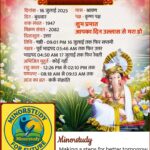🌿 Van Mahotsav – The Green Festival That Breathes Life Into Our Planet
Van Mahotsav: In a time when climate change, deforestation, and pollution loom over our future like ominous shadows, there arises a quiet yet powerful annual celebration that plants hope — quite literally. Van Mahotsav, or the Festival of Trees, is more than just a government initiative; it is a deeply spiritual and ecological movement that celebrates the sacred bond between humans and nature.
This comprehensive guide dives deep into the history, timeline, facts, FAQs, daily life impacts, significance, and social relevance of Van Mahotsav. Crafted in a human-centric, compassionate voice, this article seeks to rekindle the urgency, beauty, and hopeful spirit that this movement represents.
📜 History of Van Mahotsav
Van Mahotsav, which means “Forest Festival” in Sanskrit and Hindi, began in 1950 as a nationwide tree-planting movement to combat deforestation and ecological imbalance.
👨🌾 Visionary Behind It:
The festival was the brainchild of Kanhaiyalal Maneklal Munshi, then Union Minister for Agriculture and Food. He realized that the rapid industrialization post-independence needed a sustainable ecological counterbalance, and that balance had to begin with the forest — Earth’s lungs.
📅 First Celebration:
The first Van Mahotsav was organized in Delhi from July 20–27, 1950.
Over one million trees were planted across India that week.
The movement quickly spread to rural, tribal, and urban regions alike.
🗓️ Timeline of Van Mahotsav: Key Milestones
| Year | Event |
|---|---|
| 1950 | Van Mahotsav inaugurated in Delhi by K.M. Munshi |
| 1960s–70s | Expansion into village development programs |
| 1980s | Schools and colleges institutionalize tree plantation drives |
| 2000s | Urban development bodies adopt Van Mahotsav for greening cities |
| 2014 | Van Mahotsav integrated into “Swachh Bharat” and “Smart Cities” missions |
| 2020 | Digital Van Mahotsav campaigns launch amid COVID-19 |
| 2025 | Drone-based afforestation and youth-led eco-initiatives surge |
🌲 7 Inspiring Facts About Van Mahotsav
🌳 Over 250 million saplings have been planted since 1950 under this initiative.
🧒 Schools across India organize eco-awareness rallies, competitions, and pledges during Van Mahotsav.
🌾 It promotes indigenous species like Neem, Banyan, Jamun, Peepal, Amla, and Arjuna for biodiversity.
🌎 It aligns with India’s commitment to restore 26 million hectares of degraded land by 2030 under the Bonn Challenge.
🛕 Several temples and spiritual groups participate by planting “sacred groves.”
🏢 Corporates use it as part of their CSR (Corporate Social Responsibility) initiatives.
🌱 It’s the only tree-planting festival globally that is institutionally embedded into governance, education, and civil society.
❓ Frequently Asked Questions (FAQs) About Van Mahotsav
Q1: When is Van Mahotsav celebrated?
🗓️ First week of July every year, across all Indian states.
Q2: Why is July chosen for the event?
🌧️ The monsoon season begins in July, offering the best conditions for sapling survival due to rainfall and humidity.
Q3: Who can participate?
👨👩👧👦 Everyone! Schools, colleges, housing societies, corporates, NGOs, and individuals.
Q4: What kind of trees are planted?
🌳 Mostly native species suitable for the local environment to ensure survival and ecological balance.
Q5: Is there any religious or spiritual angle to this?
🕉️ Yes. Many Indian traditions treat trees like the Peepal and Banyan as sacred, integrating planting with spiritual merit.
🌍 Significance of Van Mahotsav in Daily Life and Society
1. 🌿 Environmental Balance
Forests control floods, prevent soil erosion, purify air, and regulate the climate. This festival is a grassroots climate action model.
2. 👩🏫 Environmental Education
Young students learn about climate change, conservation, and biodiversity through participation, not just textbooks.
3. 💼 Urban Development
It helps green urban areas, reduce pollution, create shaded walkways, and beautify cities and towns.
4. 🧘 Mental Health & Well-being
Green spaces reduce anxiety, depression, and encourage physical activity and mental rejuvenation.
5. 🐦 Biodiversity Conservation
Trees provide shelter and food for birds, insects, and animals, helping to restore ecological chains.
6. 🌱 Revival of Indian Eco-Spirituality
Van Mahotsav revives the ancient Indian philosophy of living in harmony with nature — where rivers, trees, and animals are revered.
🌳 How Van Mahotsav Is Observed: Human-Centric Celebrations
🏫 In Schools:
Tree plantation drives
Poster-making and essay-writing contests
Environmental awareness lectures
Nature walks and storytelling
🏘️ In Communities:
Local authorities organize tree drives
Parks and roadsides are beautified
Elderly and children plant together — building intergenerational bonds
🛕 By Spiritual & Religious Groups:
Sacred groves (Devarai, Panchvati) are revived
Rituals are performed while planting trees
🏢 In Corporates:
Green pledges and plantation challenges
Employee-volunteer days in eco-restoration zones
🌸 Beautiful Wishes & Messages for Van Mahotsav
🌱 “Let every hand plant a tree today. Let every heart breathe hope tomorrow.”
🌳 “Happy Van Mahotsav! A single sapling today is a forest of blessings tomorrow.”
🌾 “Celebrate the Earth. Honor her with roots that will last generations.”
🌍 “Green is not just a color; it’s our future. Happy Forest Festival!”
💚 Important Points to Remember
Trees are not decoration — they are survival.
Urban forests reduce heat by up to 4°C.
One large tree provides a day’s oxygen for four people.
Deforestation affects rainfall patterns, which impacts agriculture.
Van Mahotsav is a citizen’s duty, not just a government program.
🎯 Real-Life Impacts of Van Mahotsav
✅ Micro-Level Impact (Individuals & Families):
Improved health due to better air quality
Cost savings from cooler surroundings (reduced AC use)
Children develop love for nature
✅ Community-Level Impact:
Local biodiversity restored
Cleaner, greener public spaces
Reduction in air/noise pollution
✅ National-Level Impact:
Enhances India’s climate resilience
Helps meet international SDGs (Sustainable Development Goals)
Generates green jobs (nurseries, maintenance, ecotourism)
🧭 Conclusion: Let’s Not Just Plant Trees — Let’s Grow a Movement
Van Mahotsav is not merely an event — it is a legacy, a green inheritance that we owe our children. As urban jungles swallow green cover and nature gasps under pollution, this festival is a reminder of our sacred duty to the Earth.
The strength of Van Mahotsav lies in its simplicity: one person, one tree. Yet the outcome is profound — millions of lives impacted positively.
So this July, pick a tree, pick a place, and plant a promise — a promise to stand by Earth, now and forever.








